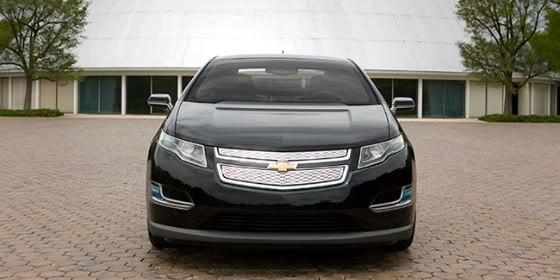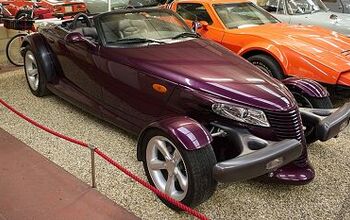Volt Birth Watch 173: Generator Mode Revealed
The Chevrolet Volt can very nearly be boiled down to a single a function: range extension. The Volt’s gasoline range-extender is the car’s major technological advantage over other electric vehicles like Nissan’s Leaf, promising consumers freedom from the terror of range anxiety. But how does it actually work? TTAC’s Volt Birth Watch has long asked the question, and GM has assiduously prevented journalists from describing the Volt’s transition from initial EV range to “generator mode.” Until now. The NY Times‘ Lindsay Brooke recently took a pre-production Volt for a spin at the Milford Proving Grounds, and files this report on the generator mode experience:
It takes a few laps of Milford’s twisty, undulating 3.7-mile road course to deplete the remaining eight miles of battery charge. With the dashboard icon signaling my final mile of range, I point the Volt toward a hill and wait for the sound and feel of the generator engine’s four pistons to chime in.
But I completely miss it; the engine’s initial engagement is inaudible and seamless. I’m impressed. G.M. had not previously made test drives of the Volt in its extended-range mode available to reporters, but I can see that in this development car, at least, the engineers got it right.
Or did they?
I push the accelerator and the engine sound does not change; the “gas pedal” controls only the flow of battery power to the electric drive motor. The pedal has no connection to the generator, which is programmed to run at constant, preset speeds. This characteristic will take some getting used to by a public accustomed to vroom-vroom feedback.
A few hundred yards later, as we snake through the track’s infield section, the engine r.p.m. rises sharply. The accompanying mechanical roar reminds me of a missed shift in a manual-transmission car. For a moment the sound is disconcerting; without a tachometer, I guess that it peaked around 3,000 r.p.m.
I asked what was going on.
“The system sensed that it’s dipped below its state of charge and is trying to recover quickly,” [Volt vehicle line director Tony Posawatz] said. “The charge-sustaining mode is clearly not where we want it to be yet.”
Immediately the engine sound disappeared, although it was still spinning the generator. A few times later in our test, the generator behaved in similar fashion — too loud and too unruly for production — but there is time for the programmers to find solutions. Volt engineers are revising the car’s control software, which will have the effect of “feathering” the transition from the nearly silent all-electric mode to the charge-sustaining mode, when the generator will be operating.
Oops! Brooke was a guest of GM, driving a much-fettled prototype on its home track. Surely GM was aware that “disconcerting” sounds accompanying the switch to generator mode would be noted with disapproval. GM’s answer?
“We’re designing a software set of rules, which will just require more seat time for the engineers to finish,” Mr. Posawatz said. “We have nine months to work this out.”
Brooke concludes by calling the Volt “an extremely refined vehicle,” giving GM’s engineers the benefit of the doubt on their attempts to smooth over the generator mode switch. When production vehicles roll out, Posawatz and company better hope the software codes are up to snuff. After all, the Volt’s range-extender is one of those technologies that doesn’t offer much marginal advantage to consumers in the typical EV early-adopter profile. It’s an attempt to make the Volt a potential replacement for a “real” ICE-powered car, making it an option for (well-heeled) mainstream consumers who might envision using it as a primary vehicle rather than a dedicated commuter. That mainstream appeal is a tough enough sale without weird engine-room thrashing. GM has got to sweat this detail.
More by Edward Niedermeyer
Latest Car Reviews
Read moreLatest Product Reviews
Read moreRecent Comments
- AZFelix I would suggest a variation on the 'fcuk, marry, kill' game using 'track, buy, lease' with three similar automotive selections.
- Formula m For the gas versions I like the Honda CRV. Haven’t driven the hybrids yet.
- SCE to AUX All that lift makes for an easy rollover of your $70k truck.
- SCE to AUX My son cross-shopped the RAV4 and Model Y, then bought the Y. To their surprise, they hated the RAV4.
- SCE to AUX I'm already driving the cheap EV (19 Ioniq EV).$30k MSRP in late 2018, $23k after subsidy at lease (no tax hassle)$549/year insurance$40 in electricity to drive 1000 miles/month66k miles, no range lossAffordable 16" tiresVirtually no maintenance expensesHyundai (for example) has dramatically cut prices on their EVs, so you can get a 361-mile Ioniq 6 in the high 30s right now.But ask me if I'd go to the Subaru brand if one was affordable, and the answer is no.


































Comments
Join the conversation
GM is betting the house on a flawed, interim technology that will be retired to the dust bin of automotive history - but the bright spot is that maybe an aftermarket kit will become available to replace that stupid lump of an ICE with a bank of ultracapacitors.